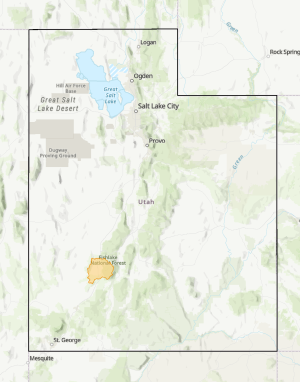Beaver River Watershed Improvement Strategic Funding Pool
Improve irrigation water systems and riparian habitats, reduce nutrient and sediment transportation, and ensure that beneficial uses of the water are attained through voluntary incentive-based programs.
Project Description
The Beaver River and Minersville Reservoir have been identified as impaired water bodies, and a Total Maximum Daily Load (TMDL) document has been written for the boundary area. Major resource concerns to be addressed include nutrients transported to ground and surface waters and sediment transported to surface waters. The community goal of this proposal is to implement resource improvements and ensure that beneficial uses of the water are attained through voluntary incentive-based programs. The economy of the watershed is based primarily on agricultural production (beef, dairy, hog, forages), recreational opportunities on nearby state parks (Minersville Reservoir), federal forestlands, and the transportation of goods along Interstate 15. The proposal will work adjacent to the Shared Stewardship Agreement of the Forest Service now in Phase III. Specific treatments include 4,000 acres of upland dominated by sagebrush and pinyon/juniper tree species, 200 acres of forestland to reduce sediment transportation, 1,000 acres of pasture/cropland to improve irrigation water systems and reduce nutrients transported to water sources and stabilize 5,000 ft of streambank along the Beaver River and its tributaries improving aquatic habitat.

- County: Beaver County
- Year active: FY 2023
- Duration: 5 years
Partners
Utah Department of Natural Resources – Watershed Restoration Initiative, Bureau of Land Management, U.S. Forest Service, Utah Department of Natural Resources – Division of Forestry Fire and State Lands, Beaver Conservation District, Utah Department of Agriculture and Food, Utah Department of Environmental Quality.
Conservation practices involved
- Waste Storage Facility (313)
- Brush Management (314)
- Herbaceous Weed Treatment (315)
- Conservation Cover (327)
- Critical Area Planting (342)
- Dam – Diversion (348)
- Sediment Basin (350)
- Diversion (362)
- Pond (378)
- Fence (382)
- Woody Residue Treatment (384)
- Riparian Herbaceous Cover (390)
- Riparian Forest Buffer (391)
- Stream Habitat Improvement and Management (395)
- Grade Stabilization Structure (410)
- Wildlife Habitat Planting (420)
- Irrigation Pipeline (430)
- Irrigation Reservoir (436)
- Irrigation System – Microirrigation (441)
- Sprinkler System (442)
- Irrigation System – Surface and Subsurface (443)
- Irrigation Water Management (449)
- Irrigation Land Leveling (464)
- Obstruction Removal (500)
- Pasture and Hay Planting (512)
- Livestock Pipeline (516)
- Pond Sealing or Lining – Compacted Soil Treatment (520)
- Pond Sealing or Lining – Geomembrane or Geosynthetic Clay Liner (521)
- Pond Sealing or Lining – Flexible Membrane (521A)
- Pond Sealing or Lining – Soil Dispersant (521B)
- Pond Sealing or Lining – Bentonite Sealant (521C)
- Pond Sealing or Lining – Compacted Clay Treatment (521D)
- Pond Sealing or Lining – Concrete (522)
- Prescribed Grazing (528)
- Pumping Plant (533)
- Range Planting (550)
- Spring Development (574)
- Stream Crossing (578)
- Streambank and Shoreline Protection (580)
- Channel Bed Stabilization (584)
- Structure for Water Control (587)
- Nutrient Management (590)
- Watering Facility (614)
- Water Well (642)
- Restoration of Rare or Declining Natural Communities (643)
- Upland Wildlife Habitat Management (645)
- Structures for Wildlife (649)
- Forest Stand Improvement (666)
When to Apply
Program applications are accepted on a continual basis. However, NRCS establishes application ranking dates for evaluation, ranking and approval of eligible applications. Applications received after the ranking date will be automatically deferred to the next funding period.
Local Working Group Meetings
Every year, NRCS hosts Local Working Group meetings where farmers, landowners, conservation partners and other members of the community discuss the natural resource needs for the county. Based on feedback from those meetings, NRCS updates the county's Local Resources Assessment Priorities (LRAP) and develops new Conservation Implementation Strategies to address those resource concerns. You may contact us anytime to express concerns or comments about conservation needs in the county, and we encourage you to attend the next Local Working Group meeting in your county. For more information about Local Working Group meetings, contact your local NRCS office, or visit our Utah State Technical Committee page.
Locally Led Conservation
At the Natural Resources Conservation Service of Utah, we understand effectively partnering with our local, county and state agencies and organizations is paramount to our mission of conserving our natural resources and helping people help the land. Utah’s diverse landscape and resource needs require strategic funding and focused efforts to support locally led conservation on the ground.
Learn more about Utah's Focused Opportunities and how NRCS is utilizing SFPs to target locally identified high priority natural resource concerns and work toward a desired outcome.

